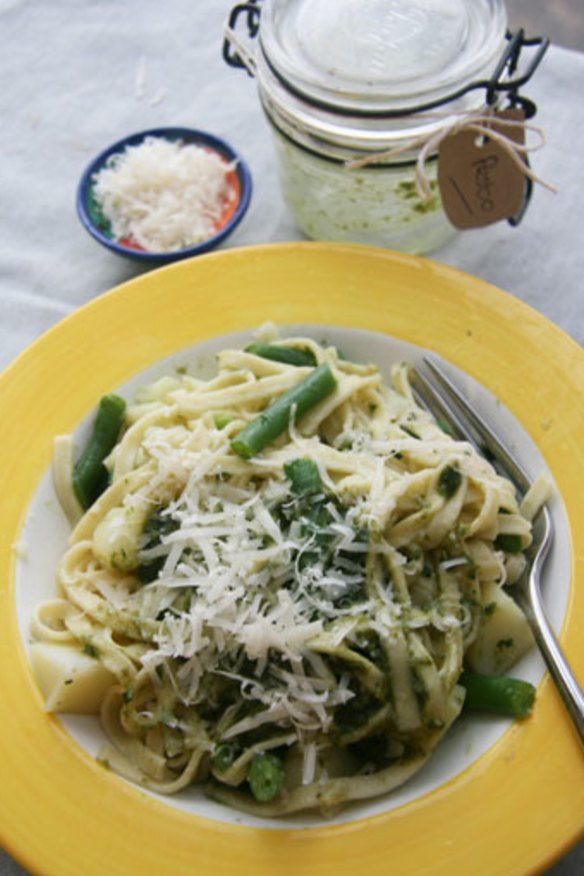How to make the perfect basil pesto

Ask two Ligurians the right way to make pesto and you’re guaranteed to get a different answer from each.
As Italian chef Lucio Galletto says, from one village to the next, even from household-to-household, the recipe changes, with some exceptions.
“With pesto it’s like Snow White and the Seven Dwarfs,” he says.
“The Snow White is the pasta and the Seven Dwarfs are the garlic, the salt, the basil, pine nuts, parmesan cheese, the pecorino from Sardinia and the olive oil.”
Galletto has lived in Australia for 34 years but grew up in Liguria in a village near the Tuscan border. The classic basil pesto, known as pesto genovese hails from this part of Italy. His version is quite mild in flavour. Head closer to Genoa and the garlic and pecorino are ramped up a bit.
“My mother used to be crazy about making pesto the right way, what she thought was the right way and which I think is the right way,” he says.
So what’s his approach?
The first step is to start with the freshest ingredients possible. The cheeses should be quite mild so choose a parmesan that’s less than two years old and a pecorino that doesn’t have too much bite – the older it gets the stronger it becomes. Grate these just before using. And choose a fruity olive oil (preferably from Liguria, of course!).
“Pesto is such a simple sauce and as with all simple recipes it needs the best you can get,” he says.
Galletto says the colour of the pesto should be pea green. Small basil leaves are best. In a story on pesto in the August 2011 edition of Saveur magazine a farmer from the Ligurian town of Pra recommends using really young plants with only four to six leaves on each.
This might be a bit difficult unless you have your own continuous basil farm in the backyard. So if big leaves are all you can get Galletto suggests cutting the stem from the middle of the leaf and discarding this. Otherwise the pesto can look and smell a bit grassy.
Pound it
Pesto is derived from the Italian word pestare which means to crush, grind or pound. If using a mortar and pestle – which Galletto believes is best – he says to start with the salt and garlic (for more on his method see the recipe below) and then add the basil leaves. The salt helps to preserve the green colour of the basil. If using a blender, just chuck all the ingredients in at once.
“Stop the blender every now and then so the pesto doesn’t get too hot,” he says. “Pulse it.”
The end result should be very smooth. The flavours should be balanced with one not overpowering the other.
Serve it up
Pesto Genovese is traditionally served with a type of linguine called trenette or Mandilli, which translates into silk handkerchief. These are large sheets of pasta, somewhere in between pappardelle and lasagne sheets.
Good news for carb lovers, the pasta is cooked with a diced potato and sliced green beans, which are eaten with the pesto sauce. The fresher the pasta the better, Galletto says. The dish is as much about showcasing the beautiful fresh pasta as it is about the basil sauce.
Variations on a theme
As for the sun dried tomato or rocket versions that grace the supermarket shelves and deli counters, this isn’t exactly a mis-use of the term pesto. They’re just not pesto genovese.
“It is interesting the way the other regions use a mortar and pestle,” he says.
“The most beautiful ones are in Sicily with pistachio nuts. It has beautiful flavour and is a lovely green colour. Another one is made with tomato and herbs.”
But the basil pesto, the pesto genovese, is always Snow White and the Seven Dwarfs.
THE RECIPE
Linguine al pesto con fagiolini e patate (Linguine with pesto, potato and green beans)
Serves 4
3 litres water
1 large waxy potato, such as desiree, peeled and diced.
300g green beans sliced
400g linguine
pesto sauce (see recipe below)
1 knob butter
freshly grated parmesan cheese to serve
Bring the water to the boil in a large saucepan, Throw in the potatoes and cook for 5 minutes. Add the beans and pasta and cook as per pasta packet directions (about 7 minutes). Strain the pasta, beans and potatoes and reserve to tablespoons of the cooking water.
Put half of the pesto into a large bowl. Add the reserved water, the pasta, beans, potatoes and butter, and toss well to coat.
Spoon the rest of the pesto on top, sprinkle on some parmesan, and serve immediately.
The pesto sauce
1 garlic clove, peeled
pinch of sea salt
40 small basil leaves, carefully washed and patted dry
1 tbls pine nuts nuts (raw, not toasted)
2 tbls freshly grated parmesan cheese
1 tbls freshly grated mild Sardinian pecorino cheese
6 tbls extra virgin olive oil, more if needed
Mortar and pestle method
Place the garlic, and salt (which helps to keep the basil green) in the mortar and start pounding, then add the basil leaves and start crushing, pressing the pestle around the sides in a rotary motion so that the ingredients meld smoothly together. Add the pine and the two cheeses and keep pounding until everything is blended to a paste. Transfer to a larger bowl and add the oil, mixing with a wooden spoon.
Blender method
Place all ingredients into a blender, and process on the lowest speed with intermittent pulsing until the sauce is creamy.
Note: If you are not using the pesto immediately, pour a layer of olive oil on top to prevent discolouration.
Source: This article was originally published as a Tried & Tasted blog entry on September 30, 2011.
The best recipes from Australia's leading chefs straight to your inbox.
Sign up